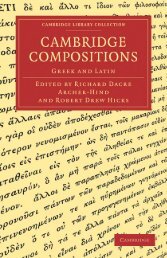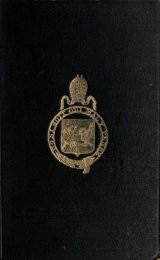- Page 2:
This page intentionally left blank
- Page 8:
COLLOQUIAL AND LITERARY LATIN edite
- Page 12:
In honour of J. N. Adams
- Page 18:
viii Contents 9 The fragments of Ca
- Page 22:
Contributors professor brigitte l.
- Page 26:
Acknowledgements Thanks are due abo
- Page 30:
xiv Foreword the University Medal f
- Page 34:
xvi Foreword and authors are concer
- Page 38:
xviii Foreword that he has studied
- Page 44:
chapter 1 Introduction Eleanor Dick
- Page 48:
Introduction 5 lacks a colloquial r
- Page 52:
chapter 2 Colloquial language in li
- Page 56:
Colloquial language in linguistic s
- Page 60:
Colloquial language in linguistic s
- Page 64:
Roman authors on colloquial languag
- Page 68:
Roman authors on colloquial languag
- Page 72:
Roman authors on colloquial languag
- Page 76:
Roman authors on colloquial languag
- Page 80:
Roman authors on colloquial languag
- Page 84:
Roman authors on colloquial languag
- Page 88:
Roman authors on colloquial languag
- Page 92:
Roman authors on colloquial languag
- Page 96:
Roman authors on colloquial languag
- Page 100:
Roman authors on colloquial languag
- Page 104:
Roman authors on colloquial languag
- Page 108:
Roman authors on colloquial languag
- Page 112:
Roman authors on colloquial languag
- Page 116:
Roman authors on colloquial languag
- Page 120:
Roman authors on colloquial languag
- Page 124:
Colloquial language in literary stu
- Page 128:
Colloquial language in literary stu
- Page 132:
Colloquial language in literary stu
- Page 136:
Colloquial language in literary stu
- Page 140:
Colloquial language in literary stu
- Page 144:
Colloquial language in literary stu
- Page 148:
Colloquial language in literary stu
- Page 152:
Colloquial language in literary stu
- Page 156:
Colloquial language in literary stu
- Page 160:
Colloquial language in literary stu
- Page 164:
Colloquial language in literary stu
- Page 168:
chapter 5 Preliminary conclusions E
- Page 172:
Preliminary conclusions 67 adhere t
- Page 176:
part ii Early Latin
- Page 182:
72 wolfgang david cirilo de melo Th
- Page 186:
74 wolfgang david cirilo de melo Th
- Page 190:
76 wolfgang david cirilo de melo Th
- Page 194:
78 wolfgang david cirilo de melo en
- Page 198:
80 wolfgang david cirilo de melo hy
- Page 202:
82 wolfgang david cirilo de melo He
- Page 206:
84 wolfgang david cirilo de melo Ex
- Page 210:
86 wolfgang david cirilo de melo Pl
- Page 214:
88 wolfgang david cirilo de melo Wh
- Page 218:
90 wolfgang david cirilo de melo su
- Page 222:
92 wolfgang david cirilo de melo In
- Page 226:
94 wolfgang david cirilo de melo sh
- Page 230:
96 wolfgang david cirilo de melo bu
- Page 234:
98 wolfgang david cirilo de melo It
- Page 238:
chapter 7 Greeting and farewell exp
- Page 242:
102 paolo poccetti (7) eugae, Demip
- Page 246:
104 paolo poccetti are more common
- Page 250:
106 paolo poccetti information abou
- Page 254:
108 paolo poccetti meaning but need
- Page 258:
110 paolo poccetti these expression
- Page 262:
112 paolo poccetti In Plautus’ di
- Page 266:
114 paolo poccetti (42) Tullius Ter
- Page 270:
116 paolo poccetti a grammaticalisa
- Page 274:
118 paolo poccetti (57) . -. . .
- Page 278:
120 paolo poccetti (64) mi homo et
- Page 282:
122 paolo poccetti This utterance i
- Page 286:
124 paolo poccetti This et tu greet
- Page 290:
126 paolo poccetti the vale that fo
- Page 294:
128 hilla halla-aho and peter krusc
- Page 298:
130 hilla halla-aho and peter krusc
- Page 302:
132 hilla halla-aho and peter krusc
- Page 306:
134 hilla halla-aho and peter krusc
- Page 310:
136 hilla halla-aho and peter krusc
- Page 314:
138 hilla halla-aho and peter krusc
- Page 318:
140 hilla halla-aho and peter krusc
- Page 322:
142 hilla halla-aho and peter krusc
- Page 326:
144 hilla halla-aho and peter krusc
- Page 330:
146 hilla halla-aho and peter krusc
- Page 334:
148 hilla halla-aho and peter krusc
- Page 338:
150 hilla halla-aho and peter krusc
- Page 342:
152 hilla halla-aho and peter krusc
- Page 346:
chapter 9 The fragments of Cato’s
- Page 350:
156 john briscoe of colloquial orig
- Page 354:
158 john briscoe be that Cato himse
- Page 358:
160 john briscoe is common in old L
- Page 364:
chapter 10 Hyperbaton and register
- Page 368:
Hyperbaton and register in Cicero 1
- Page 372:
Hyperbaton and register in Cicero 1
- Page 376:
Hyperbaton and register in Cicero 1
- Page 380:
Hyperbaton and register in Cicero 1
- Page 384:
Hyperbaton and register in Cicero 1
- Page 388:
Hyperbaton and register in Cicero 1
- Page 392:
Hyperbaton and register in Cicero 1
- Page 396:
Hyperbaton and register in Cicero 1
- Page 400:
Hyperbaton and register in Cicero 1
- Page 404:
Hyperbaton and register in Cicero 1
- Page 408:
Hyperbaton and register in Cicero 1
- Page 412:
Notes on the language of Marcus Cae
- Page 416:
Notes on the language of Marcus Cae
- Page 420:
Notes on the language of Marcus Cae
- Page 424:
Notes on the language of Marcus Cae
- Page 428:
Notes on the language of Marcus Cae
- Page 432:
26-30 31-60 21-25 Notes on the lang
- Page 436:
Notes on the language of Marcus Cae
- Page 440:
Notes on the language of Marcus Cae
- Page 444:
chapter 12 Syntactic colloquialism
- Page 448:
Syntactic colloquialism in Lucretiu
- Page 452:
Syntactic colloquialism in Lucretiu
- Page 456:
Syntactic colloquialism in Lucretiu
- Page 460:
Syntactic colloquialism in Lucretiu
- Page 464:
Syntactic colloquialism in Lucretiu
- Page 468:
Syntactic colloquialism in Lucretiu
- Page 472:
Syntactic colloquialism in Lucretiu
- Page 476:
Syntactic colloquialism in Lucretiu
- Page 480:
Syntactic colloquialism in Lucretiu
- Page 484:
Syntactic colloquialism in Lucretiu
- Page 488:
Syntactic colloquialism in Lucretiu
- Page 492:
Syntactic colloquialism in Lucretiu
- Page 496:
chapter 13 Campaigning for utilitas
- Page 500:
Style, grammar and philosophy in C.
- Page 504:
Style, grammar and philosophy in C.
- Page 508:
Style, grammar and philosophy in C.
- Page 512:
Style, grammar and philosophy in C.
- Page 516:
Style, grammar and philosophy in C.
- Page 520:
Style, grammar and philosophy in C.
- Page 524:
chapter 14 The style of the Bellum
- Page 528:
The style of the Bellum Hispaniense
- Page 532:
The style of the Bellum Hispaniense
- Page 536:
The style of the Bellum Hispaniense
- Page 540:
The style of the Bellum Hispaniense
- Page 544:
The style of the Bellum Hispaniense
- Page 548:
chapter 15 Grist to the mill: the l
- Page 552:
The quotidian in Horace, Satire 1.5
- Page 556:
The quotidian in Horace, Satire 1.5
- Page 560:
The quotidian in Horace, Satire 1.5
- Page 564:
The quotidian in Horace, Satire 1.5
- Page 568:
The quotidian in Horace, Satire 1.5
- Page 572:
Divine discourse in Virgil’s Aene
- Page 576:
Divine discourse in Virgil’s Aene
- Page 580:
Divine discourse in Virgil’s Aene
- Page 584:
Divine discourse in Virgil’s Aene
- Page 588:
Divine discourse in Virgil’s Aene
- Page 592:
Divine discourse in Virgil’s Aene
- Page 596:
part iv Early Principate
- Page 602:
282 martti leiwo lower-class dialog
- Page 606:
284 martti leiwo characterise him a
- Page 610:
286 martti leiwo that for Petronius
- Page 614:
288 martti leiwo for even the suppo
- Page 618:
290 martti leiwo creates a continuu
- Page 622:
chapter 18 Parenthetical remarks in
- Page 626:
294 kathleen m. coleman of both pro
- Page 630:
296 kathleen m. coleman but such in
- Page 634:
298 kathleen m. coleman of Ulysses
- Page 638:
300 kathleen m. coleman 2.2 Exhorta
- Page 642:
302 kathleen m. coleman ...vosdicit
- Page 646:
304 kathleen m. coleman reference t
- Page 650:
306 kathleen m. coleman Here, Prisc
- Page 654:
308 kathleen m. coleman Pliny likew
- Page 658:
310 kathleen m. coleman Nay, you yo
- Page 662:
312 kathleen m. coleman Pergamus, m
- Page 666:
314 kathleen m. coleman its reuse i
- Page 670:
316 kathleen m. coleman a particula
- Page 674:
chapter 19 Colloquial Latin in Mart
- Page 678:
320 nigel m. kay (i) At 2.27.3-4 he
- Page 682:
322 nigel m. kay 2 interjected asid
- Page 686:
324 nigel m. kay In what follows I
- Page 690: 326 nigel m. kay (ii) For instances
- Page 694: 328 nigel m. kay Linus sucks: what
- Page 698: 330 nigel m. kay formation for humo
- Page 702: 332 leofranc holford-strevens The n
- Page 706: 334 leofranc holford-strevens it in
- Page 710: 336 leofranc holford-strevens whom
- Page 714: 338 leofranc holford-strevens fight
- Page 718: 340 brigitte l. m. bauer (Fr. je lo
- Page 722: 342 brigitte l. m. bauer (5) purpur
- Page 726: 344 brigitte l. m. bauer Table 21.1
- Page 730: 346 brigitte l. m. bauer Table 21.3
- Page 734: 348 brigitte l. m. bauer We find 66
- Page 738: 350 brigitte l. m. bauer Moreover,
- Page 744: Forerunners of Romance -mente adver
- Page 752: chapter 22 Late sparsa collegimus:
- Page 756: The sources and language of Jordane
- Page 760: The sources and language of Jordane
- Page 764: The sources and language of Jordane
- Page 768: The sources and language of Jordane
- Page 772: The sources and language of Jordane
- Page 776: The sources and language of Jordane
- Page 780: The sources and language of Jordane
- Page 784: The sources and language of Jordane
- Page 788: The sources and language of Jordane
- Page 792:
The tale of Frodebert’s tail 377
- Page 796:
The tale of Frodebert’s tail 379
- Page 800:
The tale of Frodebert’s tail 381
- Page 804:
The tale of Frodebert’s tail 383
- Page 808:
The tale of Frodebert’s tail 385
- Page 812:
The tale of Frodebert’s tail 387
- Page 816:
The tale of Frodebert’s tail 389
- Page 820:
The tale of Frodebert’s tail 391
- Page 824:
The tale of Frodebert’s tail 393
- Page 828:
The tale of Frodebert’s tail 395
- Page 832:
The tale of Frodebert’s tail 397
- Page 836:
The tale of Frodebert’s tail 399
- Page 840:
The tale of Frodebert’s tail 401
- Page 844:
The tale of Frodebert’s tail 403
- Page 848:
The tale of Frodebert’s tail 405
- Page 852:
Latin colloquies 407 fetch his clot
- Page 856:
Latin colloquies 409 composed in La
- Page 860:
Latin colloquies 411 gloss, leaving
- Page 864:
Latin colloquies 413 and u in texts
- Page 868:
Latin colloquies 415 (E. Löfstedt
- Page 872:
Latin colloquies 417 Similarly, in
- Page 876:
chapter 25 Conversations in Bede’
- Page 880:
Conversations in Bede’s Historia
- Page 884:
Conversations in Bede’s Historia
- Page 888:
Conversations in Bede’s Historia
- Page 892:
Conversations in Bede’s Historia
- Page 896:
Conversations in Bede’s Historia
- Page 900:
Abbreviations abbreviations of anci
- Page 904:
Abbreviations 433 Orat. Orator Phil
- Page 908:
Abbreviations 435 Jord. Jordanes Go
- Page 912:
Abbreviations 437 Quint. M. Fabius
- Page 916:
Abbreviations 439 A. Riese, Antholo
- Page 920:
References Abbot, F. F. 1907. ‘Th
- Page 924:
References 443 (edd.), Latin et lan
- Page 928:
References 445 Bettini, M. 1982.
- Page 932:
References 447 Calboli Montefusco,
- Page 936:
References 449 Cordier, A. 1939. É
- Page 940:
References 451 Fantham, E. 1972. Co
- Page 944:
References 453 Goodyear, F. R. D. 1
- Page 948:
References 455 Herren, M. W. 1995.
- Page 952:
References 457 1927a. C. Iuli Caesa
- Page 956:
References 459 Leumann, M. 1947.
- Page 960:
References 461 (ed.) 1923. Incerti
- Page 964:
References 463 Norden, E. 1899. Die
- Page 968:
References 465 1993a. ‘Aspetti e
- Page 972:
References 467 Sato, S. 1990. ‘Ch
- Page 976:
References 469 1945. ‘Colloquial
- Page 980:
References 471 Weissenborn, W. and
- Page 984:
Ablabius 360 ablative absolute 189
- Page 988:
e for i 360, 413 elegy 215 élite s
- Page 992:
Neoteric poetry 63 n. 60 Nepos 245,
- Page 996:
spelling xvii, 20 n. 15, 54, 232 wi
- Page 1000:
(a) Latin words and expressions ab
- Page 1004:
et tu 123-4 etenim 220-1, 364-5 eti
- Page 1008:
opino(r) 17 with n. 10, 146, 224, 3
- Page 1012:
tra(ns)vorsus 158-9, 253 n. 94; de
- Page 1016:
Accius 2 Ribbeck: 141 3: 140 123: 1
- Page 1020:
4.1: 244, 248 n. 36, 250 n. 58 4.2:
- Page 1024:
7.48.1: 251 n. 69 7.77.14: 247 n. 3
- Page 1028:
Fat. 24: 38 38: 44 n. 5 Fin. 1.5: 1
- Page 1032:
5.10: 413, 417 n. 24 5.14-15: 416 5
- Page 1036:
Furius Bibaculus fr. 15 Courtney: 2
- Page 1040:
2.1.32: 44 n. 5 2.1.46: 263 2.2.10:
- Page 1044:
1069: 57 n. 39 1130: 20 1249: 43 n.
- Page 1048:
5.78.22: 323 5.82.3: 322 5.83.2: 32
- Page 1052:
41.12: 282 42.1-7: 282 42.4: 49 43.
- Page 1056:
533: 332 n. 6 579: 94 593: 213 602:
- Page 1060:
4.43: 26 4.44: 163, 174, 177 4.45:
- Page 1064:
4.4.57: 317 4.4.58-60: 317 4.5: 315
- Page 1068:
4.117-19: 272 4.271: 276 5.311: 248








